Pop Art, Again! Patrick Caulfield
While American art was “discovering” abstraction in the years immediately following World War II (1939–1945), Britain was exploring new territory. Their experience with abstraction had evolved before the war in works by artists such as Henry Moore (1898–1986), Barbara Hepworth (1903–1975), and Ben Nicholson (1894–1982).
One territory British artists explored as early as 1952 was the burgeoning commercial culture that exploded after the war. Like the later philosophical debate in American Pop Art in the early 1960s, there was a debate about what constituted “fine art” between British abstractionists and realist artists who looked to the massive amount of subject matter available from advertising, comic books, product design, and mundane aspects of everyday life.
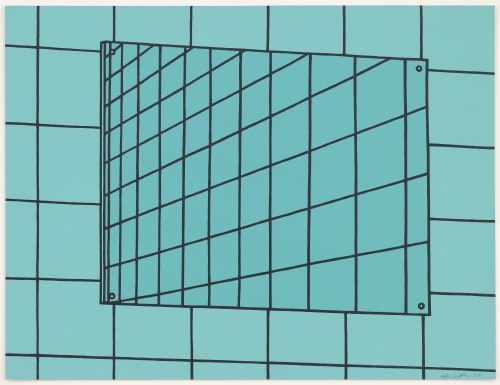 |
| Patrick Caulfield (1936–2006, Britain), Bathroom Mirror, 1968. Screenprint, 27 15/16" x 36 11/16" (71 x 93.2 cm). Museum of Modern Art, New York. © 2013 Estate of Patrick Caulfield/Artists Rights Society (ARS), New York. (MOMA-P4500clfars) |
The so-called Independent Group [including Richard Hamilton (1922–2011), John McHale (1922–1978), Eduardo Paolozzi (1924–2005), and William Turnbull (1922–2012)], starting in 1952, debated the legitimacy of popular culture as fine art subject, but eventually evolved into a group of thinkers and artists who hailed it as a sort of new paradigm, representing everyday life in a more effective and immediate way than any previous genre painting could.
Patrick Caulfield studied in London, graduating a year after most of the artists who are considered the originators of Pop Art. He adopted a technique that emulated sign painting with flat shapes and basic black outline, eliminating any personal “signature” in brush stroke or subjective connection with subjects from everyday life. Like many Pop artists in America, he preferred the screenprint medium because it eliminated any reference to personal gesture.
By the late 1960s he was producing works that are reminiscent of Photorealism/New Realism in the same stripped-down style. Bathroom Mirror is an interesting exploration of an everyday interior stripped of all but the barest elements, and yet highly evocative and recognizable as an element of modern culture. In my mind, this work is the poster child for the element of art contour line.
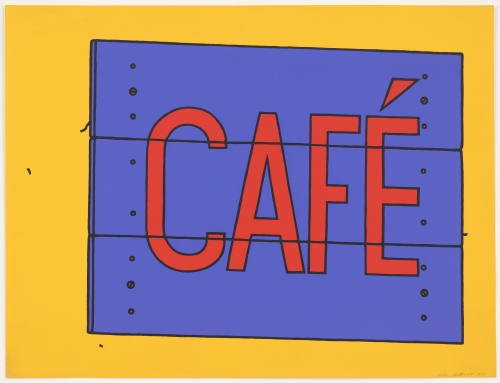 |
| Patrick Caulfield, Café Sign, 1968. Screen print. The Museum of Modern Art, New York. © 2013 Estate of Patrick Caulfield / Artists Rights Society (ARS), New York. (MOMA-P4501clfars) |
One of the artists who pioneered Pop Art in Britain, Richard Hamilton, defined it in 1957 as Popular (designed for a mass audience), transient (short-lived interest), low cost, mass produced, and youth-aimed. Here are some of his works:
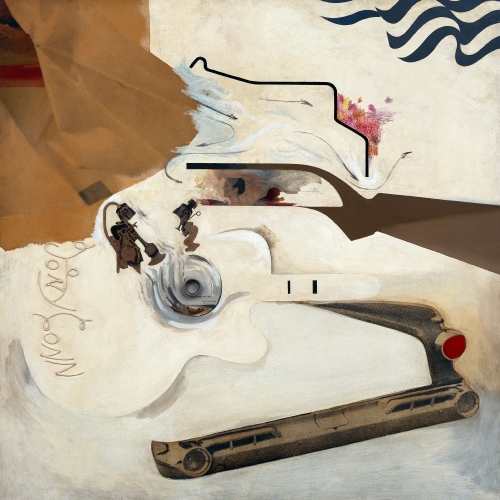 |
| Richard Hamilton, Glorious Techniculture, 1961–1964. Oil and collage on panel, 122.9 x 122.9 cm (48 3/8" x 48 3/8"). Museum of Modern Art, New York. © 2013 Estate of Richard Hamilton / Artists Rights Society (ARS), New York. (MOMA-P1113haars) |
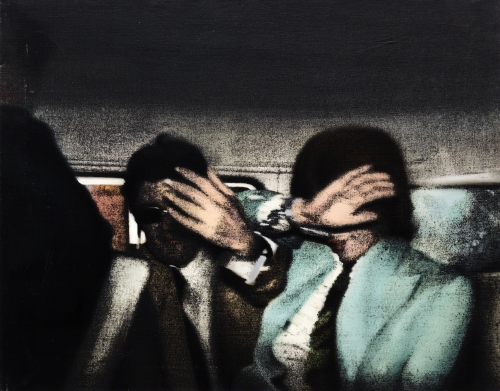 |
| Richard Hamilton, Swinging London 67, 1968–1969. Silkscreen ink on synthetic polymer paint on canvas, 67.3 x 85.1 cm (26 1/2" x 33 1/2"). Museum of Modern Art, New York. © 2013 Estate of Richard Hamilton / Artists Rights Society (ARS), New York. (MOMA-P1587haars) |
Edouardo Paolozzi was also an influential artist in the Pop art movement in Britain. Originally starting out with collages of advertising and comic characters, he eventually came to focus on sculpture that reflected industrial mass production.
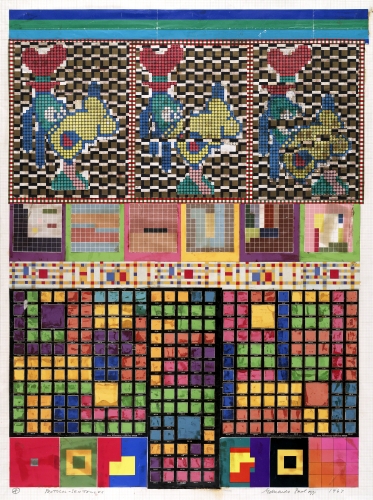 |
| Edouardo Paolozzi, No. 4 Protocol – Sentences, collage study for Universal Electronic Vacuum, 1967. Cut-and-pasted printed paper and pencil on graph paper, 104.1 x 71.1 cm (41" x 28"). Museum of Modern Art, New York. © 2013 Estate of Edouardo Paolozzi / Artists Rights Society (ARS), New York. (MOMA-P3581pzars) |
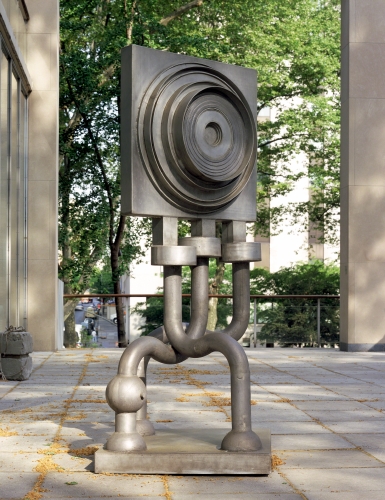 |
| Edouardo Paolozzi, Lotus, 1964. Welded aluminum, 226.1 x 92.3 x 91.6 cm (89" x 36 3/8" x 36"). Museum of Modern Art, New York. © 2013 Estate of Edouardo Paolozzi / Artists Rights Society (ARS), New York. (MOMA-S0145pzars) |
American artists who remind me of Caulfield:
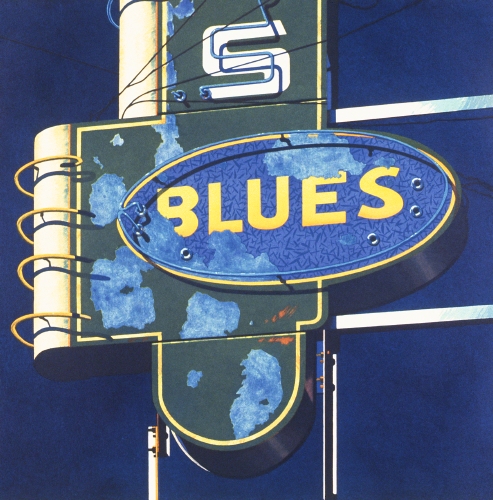 |
| Robert Cottingham (born 1935), Blues, 1989. Aquatint, 67 x 66 cm (26 3/8" x 26"). Butler Institute of American Art, Youngstown, OH. © 2013 Robert Cottingham (BIAA-286) |
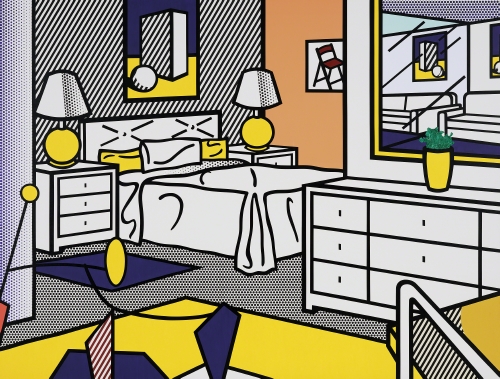 |
| Roy Lichtenstein (1923–1997), Interior with Mobile, 1992. Oil and acrylic on canvas, 330.2 x 434.4 cm (130” x 171"). Museum of Modern Art, New York. © 2013 Estate of Roy Lichtenstein (MOMA-P1257) |
Studio activity: Do a simple drawing of an everyday space. Use a pencil or felt tip pen. Reduce the space to contour lines. Contour lines define the outline of objects and details within the objects without defining shadows or volume. Try doing a drawing of a detail of a room simply in contour lines so that the composition appears abstract.
Correlations to Davis programs: Explorations in Art Grade 1: 1.4; Explorations in Art Grade 2: 6.34; Explorations in Art Grade 5: 2.7-8 studio; The Visual Experience: 16.7


Comments